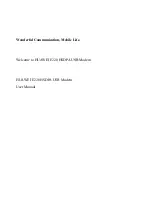
6
DL169-IN-B - CONFIGURATION
ADVANCED :
ITS ADDRES –
Address of the radiomodem unit. Allowable values between
1
and
255
. The address defines univocally each radiomodem. The
value
1
in a unit of a Point-Multipoint network operating in
Power Saving Mode
denotes the
always powered
Master Unit
.
TARGET
– Address of the destination unit. Allowable values from
1
to
255.
In all operating conditions this value
must be set
to permit the unit
identification. In
Broadcasting
and
Addr from DTE
modes, although the address is not used, it must be present.
DIGIP. –
Address of the unit used as
repeater
. Allowable values from
1
to
255.
If the value is
0
no repeater is used. The digipeater may be a
peripheral unit. In
Broadcasting mode
it first repeats the message afterwards send repeated data to the serial port. In all operating modes with
addresses the digipeater unit repeats the message without sending data to the serial port. In the
Address from DTE
mode this field is not used
and the correct addressing must be assigned from DTE.
ACK –
Selecting this option the target radiomodem when receive a valid packet answers to the source modem with an
ACK packet
. If the
source modem don’t receive the ACK, it continues to repeat the message until the receiving of an ACK. The option is available only for all
addressed modes but
not
for
Broadcasting
or
ECHO
mode. The acknowledge packet passes through the digipeaters units without repetitions.
REPETITION
– Set the numbers of the message repetitions when ACK is selected. Allowable values from 1 to 255.
NAK TO DTE –
Selecting this options the radiomodem sends a
NAK
character (ASCII 21=§ ) to the DTE when all the re-transmissions have
been unsuccessful.
ADDR TO DTE
– If selected , the receiving radiomodem sends the source unit address to the DTE. The address byte precedes the received data.
RX ADDR FOR TX
– If selected, the receiving radiomodem holds in memory all the incoming addresses and uses them in the
reversed order
for the answer. An useful option for applications with “not intelligent” DTEs.
ECHO
– If selected, the packet sent to the target radiomodem is re-transmitted to source radiomodem without releasing it to the serial port. It’s
an utility to check the radio link. This option is not available in
Broadcasting mode
.
ADDR FROM DTE
– Available only if
Rx Addr for Tx
function is
inactive
. If selected it is a duty of DTE provide to the correct addressing of
each packet. The addressing is made by some additional bytes preceding the message in the following order:
One System Code Byte [1...255]
One Flag byte
with the bit having the following scope:
bit 0 (LSB) = Broadcasting
,
bit 1 = ECHO
,
bit 2 = ACK request
, all other bits to MSB set to
0
One Unit Number Byte [1...9]
which contains both target and all the digipeaters if present
A maximum of
8 Digipeaters Addresses Bytes
in the correct sequence of use
One Target Address Byte
and then the message to be send (maximum 448 bytes).
PWSAVOFF
– It is the
Power OFF
time in the
Power Saving
cycle. This time is set with
steps of 10 milliseconds
and the alloweed values
vary from
0
to
240
. Setting this time to
0
the power saving is
inactive
and the unit is
always
operative. Of course
all units
in the network
must
be set with the same PWSAVOFF time
to allow the communication because it is used to calculate the
preamble length
. The
Power ON
time
is internally set to
13 msec
.
for CH 12.5 kHz
or
10 msec. for CH 25 kHz
. The maximum setting power off time may be of
2.40 seconds
.
Attention
!
The EN 300 220 directive imposes a maximum transmission time of 1 second.
PWSAVA
– Define the waiting time before starting the Power Saving cycle after any operation. This time
must be the same for any unit
in the
network. Maximum settable value is
254
while
255
is a reserved value that
define unit as the Master
of a point multi-point network where the
master is continuously turned-on but the preamble length is defined by the PwsavOff time.
Channel change from DTE
: the change of the channel between the (six or three) configured channels can be made through a specific frame sent
by the DTE, the feature is enabled
only if Addr from DTE is active
.
Send 3 Bytes (only 3
) in the sequence:
00h - 10h - 'New_Channel_Number'
,
where the values of
'New_Channel_Number' (
from
1
to
3
or
6)
represent the
equivalent configured channels (see table)
. A value
of
0
in the
'New_Channel_Number'
or a Radiomodem
reset restores
the
Configuration selection
. After any channel change command it’s essential to
wait at least 2 milliseconds
before proceeding with normal
activity.
In Broadcasting Mode,
due to the Addr from DTE enabled option, the DTE must precedes each data frame sent to the Master radiomodem by
the following four bytes:
System Code - 01h - 01h - 01h
.
Predefined channels in according to the EN 300 220 directive.
Canalisation 12.5 kHz
1 – 169.40625 MHz
4 – 169.44375 MHz
2 – 169.41875 MHz
5 – 169.45625 MHz
3 – 169.43125 MHz
6 – 169.46875 MHz
Canalisation 25 kHz
1 – 169.4125 MHz
2 – 169.4375 MHz
3 – 169.4625 MHz





























